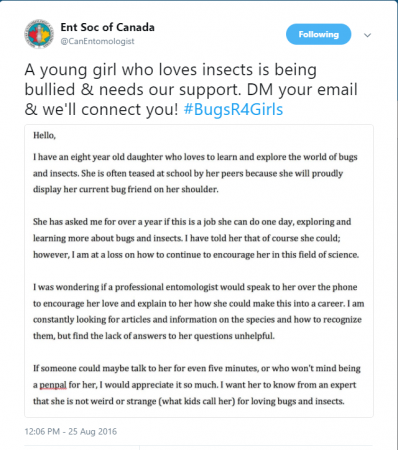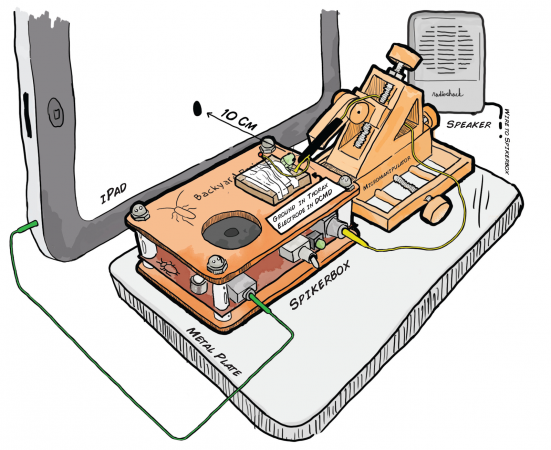-
 EducationLast year, Sophia, 8, a young entomologist, was being bullied at school because of her excitement for and interest in bugs and science. Now, just one year later, she has been published as a junior author in the Annals of the Entomological Society of America! With a craving which couldn’t be curbed to capture, observe, befriend, […]
EducationLast year, Sophia, 8, a young entomologist, was being bullied at school because of her excitement for and interest in bugs and science. Now, just one year later, she has been published as a junior author in the Annals of the Entomological Society of America! With a craving which couldn’t be curbed to capture, observe, befriend, […] -
 EducationAre you fast enough to catch a grasshopper with your bare hands? Might be tricky, because grasshoppers are quick to react to potential threats! This reaction time is thanks to a very specific, visual neural circuit in the grasshopper. By recording from this circuit in a living grasshopper prep, we can record the spikes that […]
EducationAre you fast enough to catch a grasshopper with your bare hands? Might be tricky, because grasshoppers are quick to react to potential threats! This reaction time is thanks to a very specific, visual neural circuit in the grasshopper. By recording from this circuit in a living grasshopper prep, we can record the spikes that […] -
EducationDESCRIPTION Update June, 2017: My paper was published! Check it out here in JUNE (Journal of Undergraduate Neuroscience Education). … Why are grasshoppers so hard to catch?! I aim to study the neuroscience behind this question by replicating past studies on grasshopper vision. Grasshoppers can sense an approaching object and quickly hop away to avoid collision with the object […]
-
![[Summer’16 Internship] Neuroscience of Grasshopper Jumps: Classic experiments: DCMD response to approaching balls](https://cdn.hackaday.io/images/6965281472087259884.png) EducationWith the ideal ITI determined, I can move on to the set of core experiments: testing to see how the DCMD neuron behaves when simulated black balls of different sizes and velocities approach the grasshopper’s exposed eye. So my little friends spend about 2 hours on top of the SpikerBox for these experiments. I continue to […]
EducationWith the ideal ITI determined, I can move on to the set of core experiments: testing to see how the DCMD neuron behaves when simulated black balls of different sizes and velocities approach the grasshopper’s exposed eye. So my little friends spend about 2 hours on top of the SpikerBox for these experiments. I continue to […] -
![[Summer’16 Internship] Neuroscience of Grasshopper Jumps: How does screen brightness affect DCMD response?](https://cdn.solveyourtech.com/wp-content/uploads/2012/06/change-ipad-2-screen-brightness-2.jpg) EducationNow that I’ve collected ample data for the “classic” experiment of testing the DCMD response to objects approaching at various sizes and velocities, I want to keep exploring grasshopper vision. So far, the iPad screen is kept at maximum brightness, so the contrast between the white background and the black ball is high and clear. […]
EducationNow that I’ve collected ample data for the “classic” experiment of testing the DCMD response to objects approaching at various sizes and velocities, I want to keep exploring grasshopper vision. So far, the iPad screen is kept at maximum brightness, so the contrast between the white background and the black ball is high and clear. […] -
![[Summer’16 Internship] Neuroscience of Grasshopper Jumps: New & improved ITI test](https://cdn.hackaday.io/images/1752921468206606500.png) EducationIn the ‘Preliminary data‘ log, I had begun my data collection and analysis journey. I first performed the intertrial interval, or ITI, test, to determine the ideal time between 2 stimuli so that the time is long enough to avoid the grasshoppers’ habituation to the simulated balls. The results figures I showed in that previous […]
EducationIn the ‘Preliminary data‘ log, I had begun my data collection and analysis journey. I first performed the intertrial interval, or ITI, test, to determine the ideal time between 2 stimuli so that the time is long enough to avoid the grasshoppers’ habituation to the simulated balls. The results figures I showed in that previous […] -
![[Summer’16 Internship] Neuroscience of Grasshopper Jumps: Recording live neurons: the SpikeRecorder app](https://backyardbrains.com/experiments/img/TheActionPotential_Web.jpg) EducationIn the project instructions, I’ve briefly talked about the BYB SpikeRecorder app that I’ve been using on an iPad to add to my grasshopper vision project the flavor of a low-cost-and-DIY-albeit-of-great-quality tool. Here, I’ll talk about it in a bit more details to give the spotlight to one of the main components of my project. Firstly, […]
EducationIn the project instructions, I’ve briefly talked about the BYB SpikeRecorder app that I’ve been using on an iPad to add to my grasshopper vision project the flavor of a low-cost-and-DIY-albeit-of-great-quality tool. Here, I’ll talk about it in a bit more details to give the spotlight to one of the main components of my project. Firstly, […] -
![[Summer’16 Internship] Neuroscience of Grasshopper Jumps: A new naming system for database!](https://cdn.hackaday.io/images/675821472080391922.png) EducationAs I experiment on more and more little grasshoppers, I realize the importance of organization skills. Specifically, I’m talking about how messy my housekeeping of the recordings and analyses have been. In an earlier post, I wrote that my naming system for each grasshopper is in the following format: [day][month][letter indicating order in the day]. […]
EducationAs I experiment on more and more little grasshoppers, I realize the importance of organization skills. Specifically, I’m talking about how messy my housekeeping of the recordings and analyses have been. In an earlier post, I wrote that my naming system for each grasshopper is in the following format: [day][month][letter indicating order in the day]. […] -
![[Summer’16 Internship] Neuroscience of Grasshopper Jumps: Preliminary data](https://cdn.hackaday.io/images/1752921468206606500.png) EducationAfter trials and errors, the electrophysiology setup is ready to collect usable data. I have updated the current version of the protocol and setup on the instructions tab. For housekeeping, I give each grasshopper that participates in the experiments a name in the format of [day][month][letter indicating order]. For example, a grasshopper whose DCMDs are recorded […]
EducationAfter trials and errors, the electrophysiology setup is ready to collect usable data. I have updated the current version of the protocol and setup on the instructions tab. For housekeeping, I give each grasshopper that participates in the experiments a name in the format of [day][month][letter indicating order]. For example, a grasshopper whose DCMDs are recorded […] -
EducationMaterials: check. Grasshoppers: Check. Protocol: Check, and please do check the instructions on the main project profile for the protocol of this experiment. Next step: Setting up the experiment and take off! This is how the grasshopper spends an hour of its time for science: The iPad screen is placed on the side contralateral (opposite) to where […]
-
![[Summer’16 Internship] Neuroscience of Grasshopper Jumps: Catching grasshoppers!](https://cdn.hackaday.io/images/9789911467246241161.jpg) EducationI went out to the field in Ann Arbor, MI yesterday and in my mind, I wanted to catch at least 20 grasshoppers to last me about two weeks of data collection. After two hours of navigating through a vast tall grass field in the Nichols Arboretum in the scorching summer heat, I had to […]
EducationI went out to the field in Ann Arbor, MI yesterday and in my mind, I wanted to catch at least 20 grasshoppers to last me about two weeks of data collection. After two hours of navigating through a vast tall grass field in the Nichols Arboretum in the scorching summer heat, I had to […] -
![[Summer’16 Internship] Neuroscience of Grasshopper Jumps: Designing Experimental Setup & Gathering Material](https://cdn.hackaday.io/images/8636831474752163679.png) EducationBelow is the preliminary design for my electrophysiology setup. The Backyard Brains SpikerBox has a piece of cardboard on top, so after being anesthetized in ice, the little grasshopper will chill out there for the experiment, which would last about an hour. The grasshopper’s belly (ventral side) would face up, so I can place the […]
EducationBelow is the preliminary design for my electrophysiology setup. The Backyard Brains SpikerBox has a piece of cardboard on top, so after being anesthetized in ice, the little grasshopper will chill out there for the experiment, which would last about an hour. The grasshopper’s belly (ventral side) would face up, so I can place the […]
![[Summer’16 Internship] Neuroscience of Grasshopper Jumps](https://cdn.hackaday.io/images/1343911474750447009.JPG)
![[Summer’16 Internship] Neuroscience of Grasshopper Jumps: Experimental Setup & Data Collection Begins!](https://cdn.hackaday.io/images/8975391467767138625.JPG)